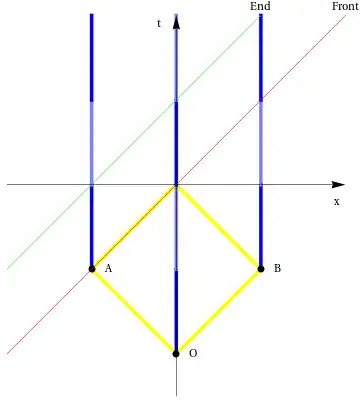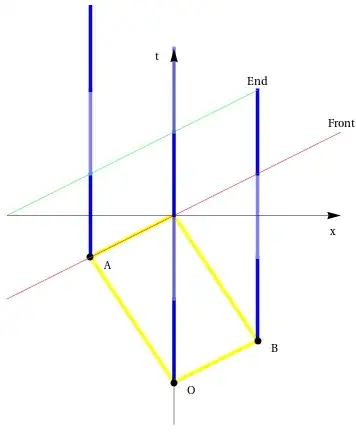Using Special relativity theory, of course. Can Lorentz transformations to "tell" something about it? "Wikipedia's" article: http://en.wikipedia.org/wiki/One-way_speed_of_light .
3 Answers
The big misunderstanding about this "one-way speed of light" thing is that there is something to be proven experimentally. While it is just a matter of convention about
how to synchronize the clocks at the source and the detector
Let me explain with an example. Consider a following experimental setup:
- We have three observers $O$,$A$ and $B$ at rest in our reference frame.
Their positions are $x_O=0, x_A=-1$ and $x_B=1$. - First they synchronize their clocks following the standard procedure:
- The $O$ observer sends a signal at $t_O=-2$ both to $A$ and $B$.
- At the moment of the signal arrival, $A$ and $B$ set their clocks to $t_{A,B}=-1$
- $A$ and $B$ return those signals and $O$ receives them back at $t_O=0$
- Clocks are synchronized.
- Now this guys measure something. For example there are two light flashes -- red and green, passing by. And observers are fixing the times of their passage.
Here is the space-time diagram for the process with the "standard" speed of light:

Such a diagram is drawn by the observers when they gather together at a meeting after the experiment was performed. Every observer has a list of events that locally happened at his place. And altogether they recreate "the big picture" of the experiment.
But now the observers have some doubts -- why do they presuppose that the speed of light is the same in both directions? So they agreed to change that and see what happens. Say that right-speed is three times as fast as the left-speed:

The description has changed. But it is just a change in the coordinates. It couldn't possibly affect any experimental predictions by any theory that observers have.
So it is just a convention. And there is nothing to be "proven" experimentally.
- 20,288
Revision: use a stationary and moving dielectric
My first answer is wrong--- you can easily imagine a model in which light components are independently cancelling without being equal. The best way is by a version of Fizeau's experiment: put a dielectric along the ongoing leg of an interferometer and not the return leg, then shift the same dielectric to the return leg while at the same time removing it from the outgoing leg (you can do this instantly by a small motion of the two beams). You can do this easily with a diamond shaped dielectric, where the back and forth directions cut on opposite tapering sides. Then you slide the diamond back and forth, removing a portion from one leg and adding the same portion to the other, and look for fringes. You won't find any.
If you believe there are mysterious fitzgerald contractions making this experiment work out, you can do Fizeau's experiment--- make the interior of the dielectric a fluid moving in a given direction. If your model is consistent with both dielectrics and Fizeau, at all seasons of the year, then you will be forced to the relativity transformation for the moving frame.
I should point out that nothing prevents you from taking the time in the rest frame of the sun (say) to be the true global time, and then doing boosts by Galilean transformations. This won't preserve the metric, but it will give different laws according to the Galilean transformed metric. In these coordinates, the light travels at different coordinate speeds back and forth, and the cancellations in the two experiments above look like miracle.
Original experiment that doesn't work
This answer is updated. Originally, I said you should make an equilateral triangle of mirrors in a Michaelson interfermeter, and check for interference fringes as you rotate the apparatus slowly. I assumed that the "back and forth" speed can't cancel on back and forth paths and triangle paths simultaneously, but this is wrong--- in the Galilean boost model, the different components parallel to the velocity do the cancelling. But in more complicated models, you could get an effect here too.
This idea is sort of silly--- the light would have to be conspiratorial for something like this to work. You didn't give a definite model, if you did, it would be easier to rule it out.
A nice animation about Michelson and Morley's Experiment can be found on: http://galileoandeinstein.physics.virginia.edu/more_stuff/flashlets/mmexpt6.htm
It clearly shows that the Aether doesn't influence the speed of light if you rotate the whole experiment about 90°. In fact Aether doesn't even exist.
- 143